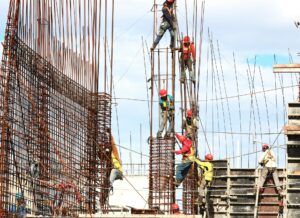A Research Article on “Sustainable Construction Material”
Introduction:
Sustainable Construction Material:
Sustainable construction materials are materials used in the building industry that are sourced, manufactured, and utilized in a manner that reduces environmental impact, conserves resources, and promotes social equity. These materials are selected based on their ability to meet the needs of the present without compromising the ability of future generations to meet their own needs, as defined by the principles of sustainability. Sustainable construction materials aim to address key challenges faced by the construction industry, including resource depletion, pollution, carbon emissions, and waste generation, while also enhancing the overall performance and resilience of built environments.

Several Characteristics Define Sustainable Construction Materials:
1. Environmental Impact: Sustainable construction materials minimize environmental impact throughout their lifecycle, from raw material extraction and manufacturing to use and disposal. This includes reducing energy consumption, greenhouse gas emissions, water usage, and waste generation associated with material production and construction processes.
2. Resource Conservation: Sustainable construction materials prioritize the efficient use of natural resources by utilizing renewable resources, recycled materials, and low-impact alternatives. This helps conserve finite resources, minimize habitat destruction, and reduce dependence on virgin materials.
3. Durability and Longevity: Sustainable construction materials are designed to be durable, resilient, and long-lasting, minimizing the need for frequent repairs, replacements, and maintenance. Durable materials contribute to the longevity of buildings and infrastructure, reducing life cycle costs and minimizing environmental impact over time.
4. Energy Efficiency: Sustainable construction materials contribute to energy efficiency by improving the thermal performance of buildings, reducing energy consumption for heating, cooling, and lighting. Energy-efficient materials, such as insulation, windows, and reflective roofing, help optimize building energy use and reduce greenhouse gas emissions.
5. Health and Well-being: Sustainable construction materials prioritize occupant health and well-being by minimizing exposure to harmful chemicals, toxins, and pollutants. Low-VOC (volatile organic compound) materials, non-toxic finishes, and natural ventilation systems help create healthier indoor environments, improving indoor air quality and occupant comfort.
6. Social Equity: Sustainable construction materials consider social equity by promoting fair labor practices, supporting local economies, and enhancing community resilience. Ethical sourcing, fair trade practices, and community engagement initiatives ensure that construction materials are produced and utilized in a socially responsible manner, benefiting local communities and workers.
Examples of sustainable construction materials include recycled aggregates, bamboo, hempcrete, recycled plastics, fly ash concrete, straw bale construction, low-VOC paints and finishes, natural and recycled insulation, and renewable energy systems. By incorporating these materials into building projects, stakeholders can contribute to the creation of more environmentally responsible, resource-efficient, and resilient built environments that support the well-being of both people and the planet.
Literature Review:
Sustainable construction is the way of adopting materials and products in building and construction that requires less use of natural resources and increases the usability of such materials and products for the same or similar purpose, thereby making reduction in waste generation as well. Moreover, sustainable construction technique enhances the resilience of the industry as such materials are readily available in the market. Steel and other metals, glass and prefabricated parts using combination of these, as well as recyclable alternatives for concrete are few examples of sustainable materials and products. Sustainable construction is to be started right with planning and design. So, the roles of developers, builders and designers are pivotal. Nevertheless, as sustainable construction involves prefabricated products also, it would be helpful to assign relevant specialists and suppliers early in the design stage. Again, implementation down the entire construction value chain is also necessary. There is a need for sharing and exchanging of knowledge and expertise in the design and the use of such materials. The capacity building and skill development in construction and installation are equally critical. From safety and quality point of view, the performance of such buildings and structures should remain high.

Conclusion:
The exploration of sustainable construction materials presented in this review underscores their pivotal role in shaping a more environmentally conscious, resilient, and resource efficient built environment. The diverse range of materials—from recycled aggregates to innovative composites—offers promising alternatives that align with the ethos of sustainability, addressing the multifaceted challenges faced by the construction industry. In conclusion, sustainable construction materials stand as catalysts for steering the construction industry toward a more sustainable paradigm. Embracing these materials represents a conscientious stride towards building structures that harmonize with the environment, enhance resilience, and leave a lasting legacy of sustainability for future generations.
ALSO READ: Affordable Housing, Climate Change and Capital Markets
